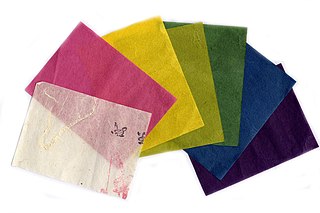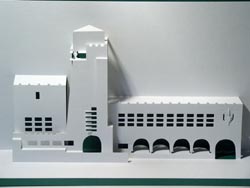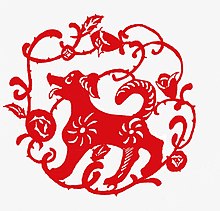
Origami is the Japanese art of paper folding. In modern usage, the word "origami" is often used as an inclusive term for all folding practices, regardless of their culture of origin. The goal is to transform a flat square sheet of paper into a finished sculpture through folding and sculpting techniques. Modern origami practitioners generally discourage the use of cuts, glue, or markings on the paper. Origami folders often use the Japanese word kirigami to refer to designs which use cuts.

The art of paper cutting in China may date back to the 2nd century CE, when paper was invented by Cai Lun, a court official of the Eastern Han dynasty.

Washi (和紙) is traditional Japanese paper processed by hand using fibers from the inner bark of the gampi tree, the mitsumata shrub, or the paper mulberry (kōzo) bush.

Paper craft is a collection of crafts using paper or card as the primary artistic medium for the creation of two or three-dimensional objects. Paper and card stock lend themselves to a wide range of techniques and can be folded, curved, bent, cut, glued, molded, stitched, or layered. Papermaking by hand is also a paper craft.

Origamic architecture is a form of kirigami that involves the three-dimensional reproduction of architecture and monuments, on various scales, using cut-out and folded paper, usually thin paperboard. Visually, these creations are comparable to intricate 'pop-ups', indeed, some works are deliberately engineered to possess 'pop-up'-like properties. However, origamic architecture tends to be cut out of a single sheet of paper, whereas most pop-ups involve two or more. To create the three-dimensional image out of the two-dimensional surface requires skill akin to that of an architect.

Papel picado is a traditional Mexican decorative craft made by cutting elaborate designs into sheets of tissue paper. Papel picado is considered a Mexican folk art. The designs are commonly cut from as many as 40-50 colored tissue papers stacked together and using a guide or template, a small mallet, and chisels, creating as many as fifty banners at a time. Papel picado can also be made by folding tissue paper and using small, sharp scissors. Common themes include birds, floral designs, and skeletons. Papel picados are commonly displayed for both secular and religious occasions, such as Easter, Christmas, the Day of the Dead, as well as during weddings, quinceañeras, baptisms, and christenings. In Mexico, papel picados are often incorporated into the altars (ofrendas) during the Day of the Dead and are hung throughout the streets during holidays. In the streets of Mexico, papel picados are often strung together to create a banner that can either be hung across alleyways or displayed in the home.
Archie Granot is a papercutting artist based in Israel. He works in traditional Jewish art, including ketubahs (ketubot), mizrachs, mezuzahs, haggadah and blessings for the Jewish life cycle, etc. Archie was born in London, England in 1946 and moved to Israel in 1967.

Scherenschnitte, which means "scissor cuts" in German, is the art of paper cutting design. The artwork often has rotational symmetry within the design, and common forms include silhouettes, valentines, and love letters. The art tradition was founded in Switzerland and Germany in the 16th century and was brought to Colonial America in the 18th century by Swiss and German immigrants who settled primarily in Pennsylvania.

Wycinanki in Poland or Vytynanky (Витина́нки) in Ukraine or Vycinanki (Выцінанкі) in Belarus, is a Slavic version of the art form of papercutting, popular in Belarus, Poland, and Ukraine.

Ise katagami (伊勢型紙) is the Japanese craft of making paper stencils for dyeing textiles. It is designated one of the Important Intangible Cultural Properties of Japan. The art is traditionally centered on the city of Suzuka in Mie Prefecture. It is different from ise washi, though both are made in Mie Prefecture.
A paper cut is a gap in skin opened by an edge of a piece of paper.

Jewish paper cutting is a traditional form of Jewish folk art made by cutting figures and sentences in paper or parchment. It is connected with various customs and ceremonies, and associated with holidays and family life. Paper cuts often decorated ketubbot, Mizrahs, and ornaments for festive occasions. Paper cutting was practiced by Jewish communities in both Eastern Europe and North Africa and the Middle East for centuries and has seen a revival in modern times in Israel and elsewhere.
Wang Zigan was a modern papercutting artist, master of arts and crafts, and famous Shanghai-style papercutter. His most important representative works are "The crowing of the cock", "Chicken eats centipede", etc. Some of his published works include "Selected papercutting works of Wang Zigan", "History of Shanghai papercutting" and "The creation of papercutting".
Shanghai-style papercutting is a variety of papercutting practiced in south China, and in particular in Shanghai.
Nahoko Kojima is a contemporary Japanese paper cut artist. She started Kirie under private tutelage at the age of five and continued throughout her formative years. In 1999 she moved to Tokyo and in 2004 she graduated from a degree in design at Kuwasawa Institute. An avid follower of fashion and trends, she found much of her inspiration in the city. She briefly pursued a career in graphic design in Tokyo before moving to London in 2005 to learn more of the Western culture of the arts. Her first solo Paper Cut show in London exhibited the five senses collection at the Epicurean Lounge in 2007.
Pabalat is a form of papercutting originating in the province of Bulacan in the Philippines. It involves making intricate papercut designs from wrappers used in pastillas and laminated as bookmarks, and usually made from papel de japon. Among the well-known practitioners of the craft are San Miguel residents Nene Luz Ocampo and her daughter, Naty Ocampo-Castro.
Kamikiri (紙切り) is the traditional Japanese art of papercutting, performed on stage to a live audience. Kamikiri as a style of performing art dates back to Edo period-Japan (1603-1867).
Paper cut sculpture, a form of papercutting, is a contemporary development of a traditional art form. Instead of flat, two-dimensional pieces, the art is given a three-dimensional form. Different artists have used a variety of different methods. A notable example is Nahoko Kojima, a Japanese artist who utilised nylon threads to suspend individual large sheets of washi paper to form the bodies of animals and other natural figures.

Christiane Luise Duttenhofer was a German papercutting artist. She was raised in a middle class Protestant family, who gave her some art education but did not permit her to become a professional artist. At the age of 28, she married her cousin, the engraver Christian Duttenhofer. She made many paper cuts, of which more than 1500 are known, including silhouette portraits that were cut freehand. Her art was largely forgotten after her death, but rediscovered in the early 20th century.

Karen Bit Vejle is a Danish papercut artist. She lived in Trondheim, Norway from 1984 to 2014, and currently lives in Denmark.

















